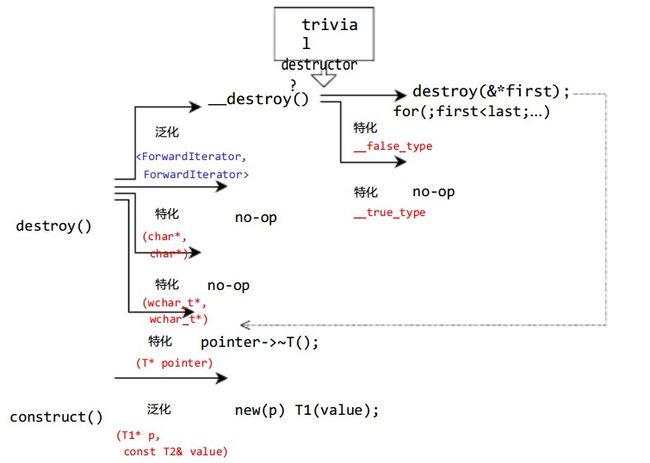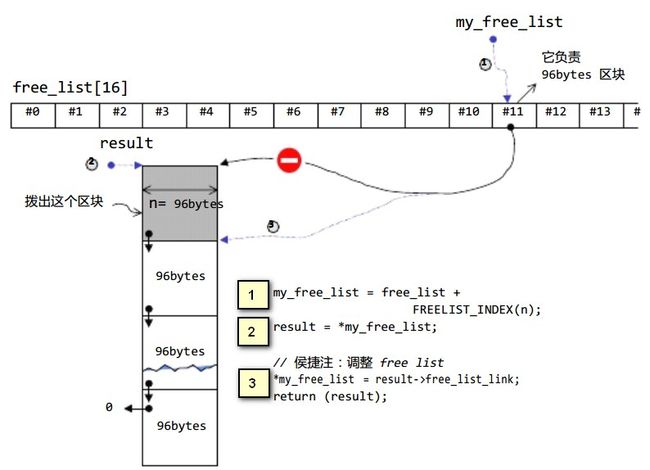SGI的内存管理
1. SGI中的内存管理
在SGI中, 其内存分配把这两步独立出了两个函数:allocate 申请内存,construct 调用构造函数,分别在
2.构造和析构的工具
在stl_construct.h中
//第一个版本destory接受一个指针,然后调用析构函数
template <class T>
inline void destroy(T* pointer) {
pointer->~T();
}
//构造函数
template <class T1, class T2>
inline void construct(T1* p, const T2& value) {
new (p) T1(value);
}
//第二个版本的destory,接收两个迭代器,并根据元素的值的类型来调用析构函数,为__false_type,调用析构,为__true_type,直接不管。
template <class ForwardIterator>
inline void
__destroy_aux(ForwardIterator first, ForwardIterator last, __false_type) {
for ( ; first < last; ++first)
destroy(&*first);
}
template <class ForwardIterator>
inline void __destroy_aux(ForwardIterator, ForwardIterator, __true_type) {}
template <class ForwardIterator, class T>
inline void __destroy(ForwardIterator first, ForwardIterator last, T*) {
typedef typename __type_traits<T>::has_trivial_destructor trivial_destructor;
__destroy_aux(first, last, trivial_destructor());
}
template <class ForwardIterator>
inline void destroy(ForwardIterator first, ForwardIterator last) {
__destroy(first, last, value_type(first));
}
//特化版本的destroy函数。
inline void destroy(char*, char*) {}
inline void destroy(wchar_t*, wchar_t*) {}3.空间配置与释放
考虑到小型区块可能造成的内存破碎问题,SGI设计了双层级配置器。第一级配置器直接使用malloc()和free(),第二级配置器对具体问题使用不同的策略。
3.1 第一级配置器
class __malloc_alloc_template {
private:
//以下函数处理内存不足的情况
//oom - out of memory
static void *oom_malloc(size_t);
static void *oom_realloc(void *, size_t);
public:
static void * allocate(size_t n)
{
void *result = malloc(n); //第一级配置器直接调用malloc
if (0 == result) result = oom_malloc(n);//无法满足需求调用oom_malloc(n)
return result;
}
static void deallocate(void *p, size_t /* n */)
{
free(p);
}
static void * reallocate(void *p, size_t /* old_sz */, size_t new_sz)
{
void * result = realloc(p, new_sz);
if (0 == result) result = oom_realloc(p, new_sz);
return result;
}
//参数为void f(),返回值也为void f(),用于自己指定oom handle
static void (* set_malloc_handler(void (*f)()))()
{
void (* old)() = __malloc_alloc_oom_handler;
__malloc_alloc_oom_handler = f;
return(old);
}
};
void (* __malloc_alloc_template<inst>::__malloc_alloc_oom_handler)() = 0;//初始值为0
template <int inst>
void * __malloc_alloc_template<inst>::oom_malloc(size_t n)
{
void (* my_malloc_handler)();//声明一个函数指针
void *result;
for (;;) {//一直尝试释放,申请
my_malloc_handler = __malloc_alloc_oom_handler;
if (0 == my_malloc_handler) { __THROW_BAD_ALLOC; }
(*my_malloc_handler)();
result = malloc(n);
if (result) return(result);
}
}
template <int inst>
void * __malloc_alloc_template<inst>::oom_realloc(void *p, size_t n)
{
void (* my_malloc_handler)();
void *result;
for (;;) {
my_malloc_handler = __malloc_alloc_oom_handler;
if (0 == my_malloc_handler) { __THROW_BAD_ALLOC; }
(*my_malloc_handler)();
result = realloc(p, n);
if (result) return(result);
}
}3.2 二级配置器
template <bool threads, int inst>
class __default_alloc_template {
private:
// Really we should use static const int x = N
// instead of enum { x = N }, but few compilers accept the former.
enum {__ALIGN = 8}; //小型区块的上调边界
enum {__MAX_BYTES = 128};//小型区块的上限
enum {__NFREELISTS = __MAX_BYTES/__ALIGN};//free_list个数
static size_t ROUND_UP(size_t bytes) {
return (((bytes) + __ALIGN-1) & ~(__ALIGN - 1));//上调的__ALIGN的倍数
}
__PRIVATE:
//obj是节点。
union obj {
union obj * free_list_link;
char client_data[1]; /* The client sees this. */
};
private:
static obj * __VOLATILE free_list[];
//获得节点的序号,0开始
static size_t FREELIST_INDEX(size_t bytes) {
return (((bytes) + __ALIGN-1)/__ALIGN - 1);
}
// Returns an object of size n, and optionally adds to size n free list.
static void *refill(size_t n);
// Allocates a chunk for nobjs of size "size". nobjs may be reduced
// if it is inconvenient to allocate the requested number.
static char *chunk_alloc(size_t size, int &nobjs);
// Chunk allocation state.
static char *start_free; //内存池的起始位置
static char *end_free; //内存池的结束位置
static size_t heap_size; //堆的大小
public:
/* n must be > 0 */
//yk:内存分配
static void * allocate(size_t n)
{ //后面介绍
};
/* p may not be 0 */
//yk : free memory
static void deallocate(void *p, size_t n)
{//后面介绍
}
// reallocate memory
static void * reallocate(void *p, size_t old_sz, size_t new_sz);
} ;
typedef __default_alloc_template<__NODE_ALLOCATOR_THREADS, 0> alloc;
typedef __default_alloc_template<false, 0> single_client_alloc;
//成员函数的初始化
template <bool threads, int inst>
char *__default_alloc_template<threads, inst>::start_free = 0;
template <bool threads, int inst>
char *__default_alloc_template<threads, inst>::end_free = 0;
template <bool threads, int inst>
size_t __default_alloc_template<threads, inst>::heap_size = 0;
template <bool threads, int inst>
__default_alloc_template<threads, inst>::obj * __VOLATILE
__default_alloc_template<threads, inst> ::free_list[
# ifdef __SUNPRO_CC
__NFREELISTS
# else
__default_alloc_template<threads, inst>::__NFREELISTS
# endif
] = {0, 0, 0, 0, 0, 0, 0, 0, 0, 0, 0, 0, 0, 0, 0, 0, };
// The 16 zeros are necessary to make version 4.1 of the SunPro
// compiler happy. Otherwise it appears to allocate too little
// space for the array.我们最关心的有三点:1. 内存池的创建。2.内存的分配。 3. 内存的释放。
1、SGI内存池的结构
内部的结构体为:
union obj {
union obj * free_list_link;
char client_data[1]; /* The client sees this. */
};
一个free_list指针指向一个128byte的空间,每个空间根据管理的大小(8,16,32……128),有不同个数的节点数目。为了节省指针的空间, 每个节点为一个union.其中的free_list_link指向下一个空的节点,client_data为柔性数组,大小为当前空间中每个区块的大小。
static obj * __VOLATILE free_list[];
为一个free_list数组,有16个free_list,每个free_list也为一个obj,它有一个指针,指向自己管理的空间第一个节点,它的free_list_link指向第一个自己管理的大小的空间。比如说,#11号区域,刚开始的时候,它是管理一个96byte的空间的,它自己的占用的空间存放的是这个96byte的起始地址,它的free_list_link也是指向这个地址,如果这个空间被别人申请了,那么,申请的时候就会让它指向下一个96byte的空间。
2、内存分配
内存分配的源码如下:
static void * allocate(size_t n)
{
obj * __VOLATILE * my_free_list;
obj * __RESTRICT result;
if (n > (size_t) __MAX_BYTES) {//大于128byte,直接调用一级配置器
return(malloc_alloc::allocate(n));
}
my_free_list = free_list + FREELIST_INDEX(n);//找到合适的序号的地址
result = *my_free_list;
if (result == 0) {//没有找到合适的,准备重新填充
void *r = refill(ROUND_UP(n));
return r;
}
*my_free_list = result -> free_list_link;//重新调整free_list
return (result);
};3、空间释放
static void deallocate(void *p, size_t n)
{
obj *q = (obj *)p;
obj * __VOLATILE * my_free_list;
if (n > (size_t) __MAX_BYTES) {//大于128byte,调用第一级配置器
malloc_alloc::deallocate(p, n);
return;
}
//否则回收
my_free_list = free_list + FREELIST_INDEX(n);
q -> free_list_link = *my_free_list;
*my_free_list = q;
}4、重新填充 free_list,
当free_list中没有可用区块了,就refill(),准备为free_list重新填充空间。新的空间将取自内存池,一般取20个新节点,如果空间不足的话,可能取不到。
template <bool threads, int inst>
void* __default_alloc_template<threads, inst>::refill(size_t n)
{
int nobjs = 20;//默认20个区块
char * chunk = chunk_alloc(n, nobjs);//调用chunk_alloc
obj * __VOLATILE * my_free_list;
obj * result;
obj * current_obj, * next_obj;
int i;
if (1 == nobjs) return(chunk);//只申请到一个区块,也是惨,直接返回这个区块
my_free_list = free_list + FREELIST_INDEX(n);//申请的比较多的话,my_free_list现在指向n大小的free_list
/* Build free list in chunk */
//以下在申请的空间创建free_list
result = (obj *)chunk;//保存返回值
*my_free_list = next_obj = (obj *)(chunk + n);//这是第一个
for (i = 1; ; i++) {//从第一个开始,第0个给客户端了。
current_obj = next_obj;
next_obj = (obj *)((char *)next_obj + n);
if (nobjs - 1 == i) {//没有了
current_obj -> free_list_link = 0;
break;
} else {//如果还有,指向下一个obj
current_obj -> free_list_link = next_obj;
}
}
return(result);
}5、内存池
template <bool threads, int inst>
char*
__default_alloc_template<threads, inst>::chunk_alloc(size_t size, int& nobjs)
{//开始申请空间
char * result;
size_t total_bytes = size * nobjs;//想要申请的空间,想想就好
size_t bytes_left = end_free - start_free;//剩余的空间
if (bytes_left >= total_bytes) {//剩余的空间比较多,直接给他就好了
result = start_free;
start_free += total_bytes;
return(result);
} else if (bytes_left >= size) {//如果剩余空间不多,但还是至少有一个size的大小
nobjs = bytes_left/size; //就尽量分给他
total_bytes = size * nobjs;
result = start_free;
start_free += total_bytes;
return(result);
} else {//实在没有办法,只能去malloc了
size_t bytes_to_get = 2 * total_bytes + ROUND_UP(heap_size >> 4);
// Try to make use of the left-over piece.
if (bytes_left > 0) {//剩余的空间,直接放到free_list中。因为申请的时候是按8的倍数来申请
//这里不会有小区块的问题
obj * __VOLATILE * my_free_list =
free_list + FREELIST_INDEX(bytes_left);
((obj *)start_free) -> free_list_link = *my_free_list;
*my_free_list = (obj *)start_free;
}
//开始申请了
start_free = (char *)malloc(bytes_to_get);
if (0 == start_free) {//oh,没有申请成功
int i;
obj * __VOLATILE * my_free_list, *p;
// Try to make do with what we have. That can't
// hurt. We do not try smaller requests, since that tends
// to result in disaster on multi-process machines.
//从自己有的资源里面去找
for (i = size; i <= __MAX_BYTES; i += __ALIGN) {
my_free_list = free_list + FREELIST_INDEX(i);
p = *my_free_list;
if (0 != p) {//这是找到了
*my_free_list = p -> free_list_link;
start_free = (char *)p;
end_free = start_free + i;
return(chunk_alloc(size, nobjs));//调整一下
// Any leftover piece will eventually make it to the
// right free list.
}
}
end_free = 0; // In case of exception.实在没有空间了,调用一级配置器,看看oom机制
start_free = (char *)malloc_alloc::allocate(bytes_to_get);
// This should either throw an
// exception or remedy the situation. Thus we assume it
// succeeded.
}
//这是申请成功的,调用自己,修正nobjs
heap_size += bytes_to_get;
end_free = start_free + bytes_to_get;
return(chunk_alloc(size, nobjs));
}
}举个例子:
1.调用chunk_allock(32,20):malloc分配40个32byte区域,第一块个客户端,19块给free_list[3],剩余20块给内存池
2.调用chunk_allock(64,20):free_list[7]为空,那么向内存池请求,内存池只有10个,就把这10个给他,第一个交给客户端,剩余9个给free_list[7]维护
3(自己加的).调用chunk_allock(32, 20):free_list[6]为空,内存池啥也没有,如果malloc失败,在自己free_list[7]找到一块,把free_list[7]的一个拿出来释放到内存池,然后调用自己,这里,内存池现在有64byte,因此可以申请两个32bytes,一个给客户端,一个由free_list[6]维护
4.接下来调用chunk_alloc(96,20):free_list[11]为空,向内存池请求,内存池也没有,只能调用malloc(),40+n个96bytes区块,d第一个给客户端,19个给free_list[11],剩余20+n给内存池



